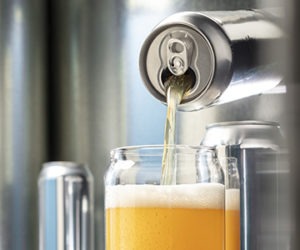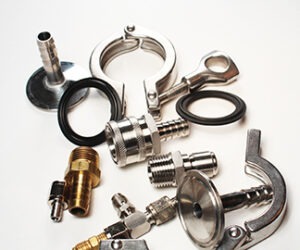Expanding Equipment: Tips from the Pros
When it comes to homebrew equipment, you can spend as much (or as little) as you’d like and still make quality beer. but there comes a point when every homebrewer decides it’s time to get bigger and better equipment. When that time comes, there are certain tools that the experts recommend, and certain tools they wouldn’t brew without.
Chris Graham is the Chief Operating Officer of MoreBeer! in Concord, California. Chris has been homebrewing for more than 15 years. Each year he teaches the Advanced Homebrewing class at the Siebel Brewing School in Colorado. He also sits on the Brewers Association’s Board of Directors, the American Homebrewers Association’s Governing Council, and BYO’s Editorial Review Board.
I like to make sure people have an understanding of three things before they expand their homebrewing equipment: Fermentation temperature control, bottling or kegging, and the size of their boil.
Fermentation temperature control is key to making consistently good beer. You can do many more things when expanding your brewery, but if you don’t plan on having a controllable fermentation temperature, you’re bound to have limitations or issues.
For most people, kegging is so much easier than bottling that I encourage new homebrewers to consider it pretty quickly, as anything that makes cleaning quicker keeps people in the hobby longer.
The size of the boil speaks to two main things; full volume boil vs. partial boil, as well as what batch size you make. Full volume boil, which means you need a kettle that can handle your batch size plus 20% (or more), makes the biggest quality improvement for many people. The best time to be thinking what size batch is ideal for you is when you are making this upgrade. If you want to increase your batch size from 5-gallons (19-L), then 10- to 12-gallon (38- to 45-L) final batch sizes are extremely popular for a few reasons. It usually takes the same amount of time while also maximizing your setup and cleanup times. There is also a financial savings because, while making twice as much beer, it usually doesn’t cost twice as much; in fact it’s usually just a small percentage more (for the equipment). Another fun, added benefit at that size is the potential to split batches and conduct experiments such as using different yeasts, different temperatures, and/or different dry hops to make a base beer taste different.
After the kettle to allow for full volume boils, if you are upgrading equipment on a tight budget, I would encourage you down a path of getting a wort chiller and usually an outdoor burner. After that, a used chest freezer (or refrigerator) and temperature controller can go a long way to ensuring you’re making great beer.
If you are trying to go all into the hobby then, again, buy the items to get to full volume, and then buy a temperature controller for fermentation or a temperature controlled conical if you want to have ultimate ease and looks. After that, consider if you want to go all-grain down the road and if so, what kind of control do you wish to have?
Other equipment like an oxygenation system, refractometer, and software are usually thought of as more advanced equipment, but shouldn’t be overlooked when upgrading. Oxygen is important to yeast health and incorporating this into your brewing is easy at any experience level.
Refractometers allow you to take quick gravity readings at any stage of the brew process (here’s a story from BYO’s archives for more on how to use them: https://byo.com/story1313). Knowing what your sugar levels are at any stage of the process will help you become a better brewer faster and have a better knowledge of what is going on in the batch.
Software, while it isn’t required to make good beer, helps you get better at planning as well as recording results, which means you will more easily remember the details and the process will be more repeatable.
John Blichmann is the President and Founder of Blichmann Engineering. An avid homebrewer for two decades, John “retired” from an engineering supervisor position at Caterpillar to start Blichmann Engineering in 2001 in order to focus on designing and producing homebrewing equipment.
The best investment I have made in my homebrewery is equipment that makes cleaning faster and more convenient. A commercial stainless steel sink with sideboards is an awesome piece of equipment, but a large plastic laundry tub in a convenient area does a fine job at a fraction of the price. Used res-taurant equipment houses are a gold mine for homebrewers. The other huge improvement for me was a dedicated area where I didn’t need to drag out all my gear each brew day.
The workhorse tools of a brewery are the brew pots and the heating sources (gas and electric). Even budget-conscience brewers should consider the options carefully when getting into the hobby. A saying I’ve always liked is, “A cheap tool is an expensive tool.” If you’re already equipped there, identify the things that take the most time or are the most frustrating when you are looking to upgrade equipment. For me, waiting for water to heat and wort to cool were not value added. A fast chiller and an efficient, powerful burner were solid investments. Or it could be a large sink for cleaning, dedicated shelving units, wort pumps, or a kegging system. For those with a higher budget, automated temperature control, brewing stands and moving your brewery indoors are great upgrades.
Before you buy anything, think long-term about what equipment you’ll need to support that vision and how much you’re willing to invest in your hobby. Specifically, consider batch size and whether you envision all-grain brewing in your future. Answers to those two questions now will steer you away from equipment that will eventually become obsolete.
If you like to build your own equipment there are many sources in the market. But be cognizant of what the real cost is in your time, material, tools, shipping costs, supplies, etc. Often it’s more a decision of wanting to build rather than saving money in the end. A few great projects are a dispensing chest freezer, immersion chiller, or an efficient brewing area.





